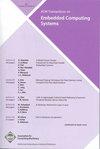ANV-PUF: Machine-Learning-Resilient NVM-Based Arbiter PUF
IF 2.6
3区 计算机科学
Q2 COMPUTER SCIENCE, HARDWARE & ARCHITECTURE
引用次数: 0
Abstract
Physical Unclonable Functions (PUFs) have been widely considered an attractive security primitive. They use the deviations in the fabrication process to have unique responses from each device. Due to their nature, they serve as a DNA-like identity of the device. But PUFs have also been targeted for attacks. It has been proven that machine learning (ML) can be used to effectively model a PUF design and predict its behavior, leading to leakage of the internal secrets. To combat such attacks, several designs have been proposed to make it harder to model PUFs. One design direction is to use Non-Volatile Memory (NVM) as the building block of the PUF. NVM typically are multi-level cells, i.e, they have several internal states, which makes it harder to model them. However, the current state of the art of NVM-based PUFs is limited to ‘weak PUFs’, i.e., the number of outputs grows only linearly with the number of inputs, which limits the number of possible secret values that can be stored using the PUF. To overcome this limitation, in this work we design the Arbiter Non-Volatile PUF (ANV-PUF) that is exponential in the number of inputs and that is resilient against ML-based modeling. The concept is based on the famous delay-based Arbiter PUF (which is not resilient against modeling attacks) while using NVM as a building block instead of switches. Hence, we replace the switch delays (which are easy to model via ML) with the multi-level property of NVM (which is hard to model via ML). Consequently, our design has the exponential output characteristics of the Arbiter PUF and the resilience against attacks from the NVM-based PUFs. Our results show that the resilience to ML modeling, uniqueness, and uniformity are all in the ideal range of 50%. Thus, in contrast to the state-of-the-art, ANV-PUF is able to be resilient to attacks, while having an exponential number of outputs.ANV-PUF:基于机器学习弹性nvm的仲裁PUF
物理不可克隆函数(puf)被广泛认为是一种有吸引力的安全原语。他们利用制造过程中的偏差来对每个设备产生独特的响应。由于它们的性质,它们作为设备的dna一样的身份。但是puf也成为了攻击的目标。已经证明,机器学习(ML)可以用来有效地建模PUF设计并预测其行为,从而导致内部秘密的泄露。为了对抗这种攻击,已经提出了几种设计,以使puf更难建模。一个设计方向是使用非易失性存储器(NVM)作为PUF的构建块。NVM通常是多级单元,也就是说,它们有几个内部状态,这使得建模变得更加困难。然而,目前基于nvm的PUF技术仅限于“弱PUF”,即输出的数量仅随输入的数量线性增长,这限制了可以使用PUF存储的可能的秘密值的数量。为了克服这一限制,在这项工作中,我们设计了仲裁者非易失性PUF (ANV-PUF),它的输入数量呈指数增长,并且对基于ml的建模具有弹性。这个概念是基于著名的基于延迟的仲裁器PUF(它对建模攻击没有弹性),同时使用NVM作为构建块而不是交换机。因此,我们用NVM的多级属性(很难通过ML建模)取代了开关延迟(很容易通过ML建模)。因此,我们的设计具有Arbiter PUF的指数输出特性和抵御基于nvm的PUF攻击的弹性。我们的结果表明,对ML建模的弹性、唯一性和均匀性都在50%的理想范围内。因此,与最先进的技术相比,ANV-PUF能够抵御攻击,同时具有指数级的输出数量。
本文章由计算机程序翻译,如有差异,请以英文原文为准。
求助全文
约1分钟内获得全文
求助全文
来源期刊

ACM Transactions on Embedded Computing Systems
工程技术-计算机:软件工程
CiteScore
3.70
自引率
0.00%
发文量
138
审稿时长
6 months
期刊介绍:
The design of embedded computing systems, both the software and hardware, increasingly relies on sophisticated algorithms, analytical models, and methodologies. ACM Transactions on Embedded Computing Systems (TECS) aims to present the leading work relating to the analysis, design, behavior, and experience with embedded computing systems.
 求助内容:
求助内容: 应助结果提醒方式:
应助结果提醒方式:


